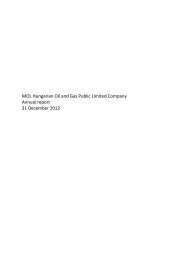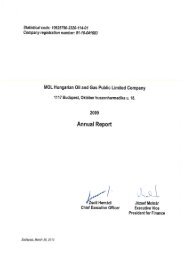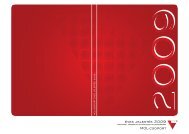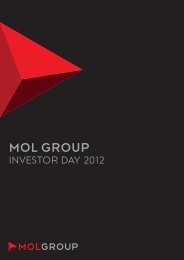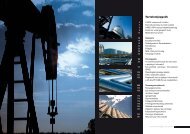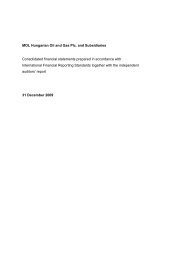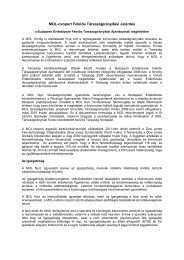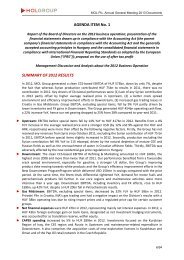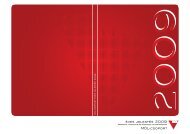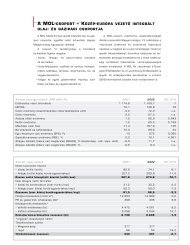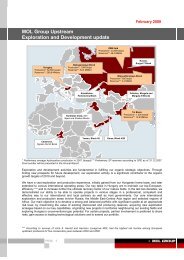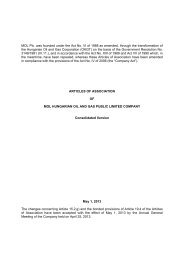MOL GROUP Annual Report
MOL GROUP Annual Report
MOL GROUP Annual Report
- No tags were found...
You also want an ePaper? Increase the reach of your titles
YUMPU automatically turns print PDFs into web optimized ePapers that Google loves.
Objective Result Fulfillment of the task *6. Manage Opportunities, Risk and Liabilitiesin the Value ChainHave a total reportable occupational illness frequency (TROIF) ofzeroHave each business unit contribute by involving at least 75%of employees in the Workplace Health Promotion Programme(‘STEP’), and keep Absence Rate under 2.5% (<strong>MOL</strong>, SN, SPC,TVK)Have no work-related fatalities in <strong>MOL</strong> Group (staff, contractorsand third parties)Reduce lost time injury frequency (LTIF) to below 1.0Road accident rate (RAR) should not exceed 1.67. Capitalise on Human ResourcesExtend the Employee Performance Management Systemto Hungarian <strong>MOL</strong> Group companies (<strong>MOL</strong>-LUB, FGSZ andPetroszolg)Create a Group level guideline for equal opportunities and worklifebalance; prepare our first equal opportunity plan (EOP)* – level of fulfillment of the task ( =100%)There were no occupational illnesses in <strong>MOL</strong> GroupThe participation rate at our STEP Programme reached 81%,while the absence rate was 1.8%,far better than the target1 own staff, 2 contractor, 1 third party fatalityWithin the <strong>MOL</strong> Group (excluding INA), the LTIF rate roseabove our target (1.5), but most of the injuries were nottechnology related (22 slips/ trips/falls out of the total 40 LTIs)RAR of 1.22, far better than our targetEPMS now covers more than 80% of Hungarian<strong>MOL</strong> Group employeesBase principles were integrated in the New Europe Programmesigned at the beginning of 2011 by the European Workers'Council. A handbook on how to make an EOP was prepared forsubsidiaries.1.2 New strategic sustainable development (SD) objectivesIn 2010, the seven SD strategic initiatives for the period 2006-2010 were reviewed and updated. After a series of discussionsand workshops, six SD focus areas were defined for the period 2011-2015: climate change, environment, health and safety,communities, human capital and economic sustainability. The six focus areas cover 20 topics, all of them considered essentialto the successful management of the long-term economic, social and environmental challenges <strong>MOL</strong> Group faces in the future.The strategic objectives have been broken down by business division and country/company level. We aim to finalise thetarget setting and action planning process by mid-2011.The main objective at the Group level is to ’achieve and maintain an internationally acknowledged leading position (top20%) in sustainability performance.’1.3 Targets for 2011 in the six focus areas of sustainabilityClimate Change– Reduce specific GHG emissions by 1% (baseline YE2010);– Obtain geothermal concession for the pilot project and executing geothermal related R&D activities;– Finalise the integration of the biogas plant into refinery systems and start the construction work;– Continue the investigation of possibilities to use renewable energy sources in refining:- Continue research on algae-based technology for CO2 fixation and biocomponent production;- R&D on new generation biofuels and further improvement of technology includingalgal biomass utilisation as biogas or biodiesel feedstock;- Increase the ratio of recycled vegetable oil (used cooking oil) in the fuel pool.Environment– Using a risk-based approach, decrease the amount of known (YE2010) environmental liabilitiesacross <strong>MOL</strong> Group by 5%;– Establish a group and business unit biodiversity system.Health and Safety– Ensure total reportable occupational illness frequency (TROIF) of zero;– Achieve 15% regularity rate in the STEP (WHP) Programme by the end of the year (<strong>MOL</strong> , TVK , SN , SPC);– Achieve zero work-related fatal accidents across <strong>MOL</strong> Group (staff, contractors and third parties);– Ensure LTIF is less than 1.0;– Ensure RAR is not higher than 1.6.Communities– Define general rules valid for all <strong>MOL</strong> Group companies engaged in advertising to guaranteeresponsible marketing.Human Capital– Enhance employer branding (strategy and image design) based on the results of theEmployer Branding Survey of 2010;– Preparation for the extension of the Employee Performance Management System in INA;– Extend the Equal Opportunities Plan to major Hungarian subsidiaries;– Continue the Professional Competency Development Program (Petroskills) in Exploration and Production andextend to R&M and HSE.Economic Sustainability– Issue a Business Continuity Management regulation valid for the <strong>MOL</strong> Group, and roll out first phase;– Increase ethics awareness, improve the ethics management at the Group level, and implement allactions planned for 2011.2 Environmental Performance2.1 Climate changeIn 2010, we spent our efforts on continuing the implementation of the action plans defined in the framework of <strong>MOL</strong>Group’s Climate Change Statement that was adopted in 2009.At the legislative level, a CO2 benchmarking system was developed by the European Commission in dialogue withstakeholders. This benchmarking system will drive CO2 reductions at least until 2020. <strong>MOL</strong> Group, via its membershipin industrial associations, took an active part in the effort to balance challenging benchmarks with ensuring thecompetitiveness of our businesses on a global scale.As in previous years, <strong>MOL</strong> also participated in the Carbon Disclosure Project in 2010, where climate change related dataare collected on behalf of major global investors. Parallelly, we enhanced our reporting of indirect GHG emissions.Renewable energyThe achievements of the key renewable energy projects are summarised below:– Second generation biofuel research: Based on broader feedstock, <strong>MOL</strong> is preparing for the timely fulfillmentof the EU Renewable Energy Directive through the production of bio-components in a more economic andefficient manner. The first phase of the project resulted in patented results and the consortium submitted a newtender to the National Office for Research and Technology (NKTH) for phase II.– Biogas produced from the organic waste of our bio-diesel factory can substitute approximately 10% of the DunaRefinery’s heating needs, currently provided by natural gas. Following the completion of the feasibility study,sample measurements and an estimation of the main technical parameters, the financial viability of the projectis currently under investigation.– Algae oils are third-generation bio-fuel feedstock for biodiesel production: <strong>MOL</strong> DS Development has started analgae research project in Százhalombatta. Based on our laboratory experiments, we have installed a pilot reactorto continue our research towards capturing CO2 from refinery flue gases and profitable algae oil production.– Geothermal energy: In line with European renewable targets, a new technological and business model wasdeveloped by the Supply and Trading Division to utilise geothermal potential in Hungary and Croatia. Based onavailable assets (available 2D and 3D seismic data), some of the suitable reservoirs have been explored. ThroughCEGE (company owned 50% by <strong>MOL</strong>), EUR 1.4 million was spent on this research with promising results. Fromboth the technical and financial point of view, the project is ready to be launched with the aim of starting theproduction by 2014.– More efficient biofuels: since European regulations support biodiesel production from non-edible and wastefeedstock, important steps have been taken to realise a project dealing with the municipal collection of usedcooking oil as feedstock for our joint venture biodiesel company, Rossi (HU). Collection will occur at <strong>MOL</strong>’s ownfilling stations.Energy efficiency and GHG emissions<strong>MOL</strong>’s continued focus on improving energy efficiency was reflected in the reduction of CO2 emissions from installationssubject to the emission trading scheme (ETS). In practice, 96% of all CO2 releases within the <strong>MOL</strong> Group (without INA)Sustainability180 <strong>MOL</strong> Group annual report 2010 181



